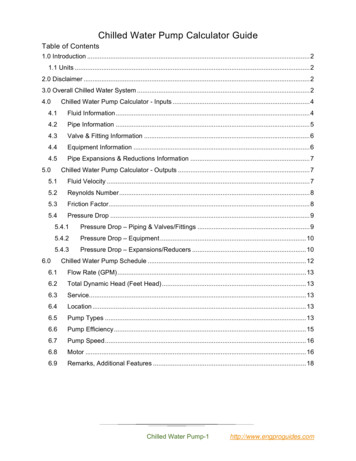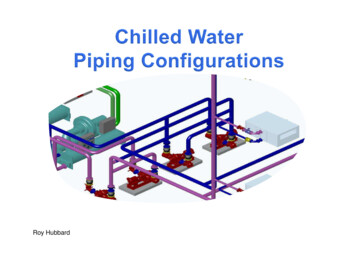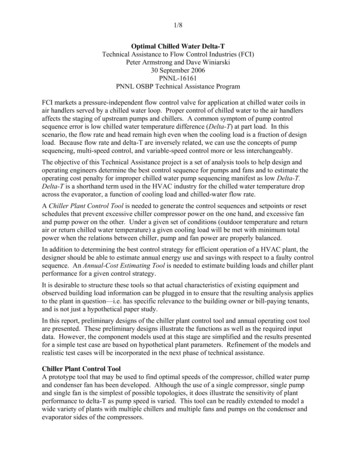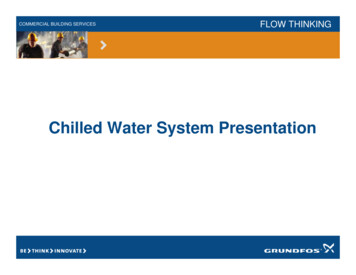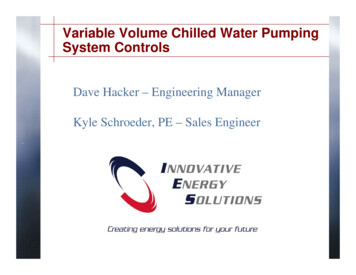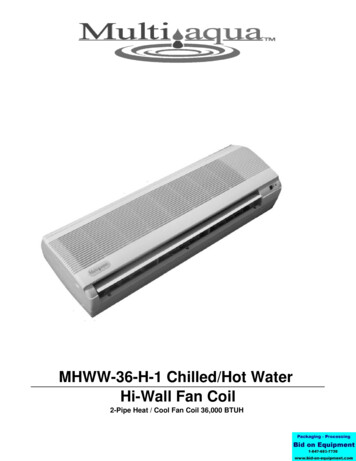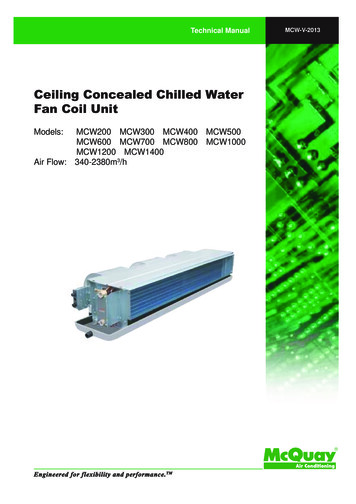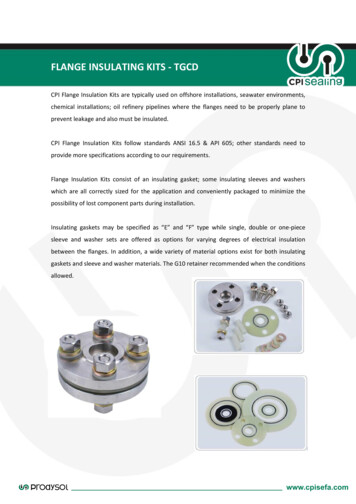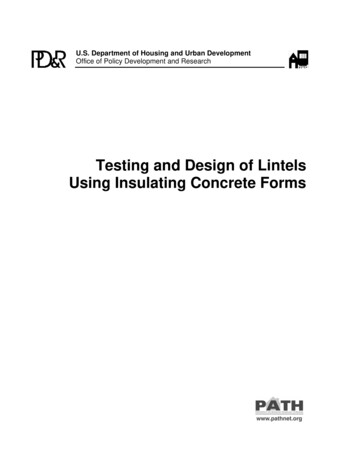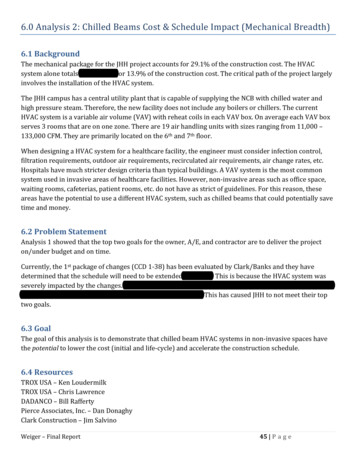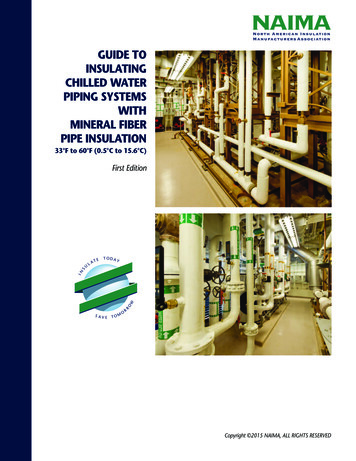
Transcription
GUIDE TOINSULATINGCHILLED WATERPIPING SYSTEMSWITHMINERAL FIBERPIPE INSULATION33 F to 60 F (0.5 C to 15.6 C)First EditionCopyright 2015 NAIMA, ALL RIGHTS RESERVED
GUIDE TO INSULATINGCHILLED WATER PIPINGSYSTEMS WITHMINERAL FIBERPIPE INSULATION33 F to 60 F (0.5 C to 15.6 C)First Edition, 2015
Guide to Insulating Chilled Water SystemsFirst Edition, 2015CONTENTSPREFACEAPPENDIX Mineral Fiber Pipe Insulation . . . . . . . . . . . . . . . . . . . ii Information Sources and References. . . . . . . . . . . . A-2 Vapor Retarder Jacketing Systems. . . . . . . . . . . . . . . . ii ASHRAE - American Society of Heating, Refrigerating, Mineral Fiber Pipe Insulation Standards . . . . . . . . . . . ii How This Guide Was Developed . . . . . . . . . . . . . . . . iii SECTION 1: PERFORMANCE CRITERIA1-1 Role of Pipe Insulation. . . . . . . . . . . . . . . . . . . . . . . 1-2 Role of Pipe Insulation for Chilled Water Systems 33 F to 60 F (0.5 C to 15.6 C) . . . . . . . . . . . . . . . . 1-2General Requirements for Mineral Fiber PipeInsulation in Chilled Water Applications . . . . . . . . . 1-2Thermal Conductivity . . . . . . . . . . . . . . . . . . . . . . . 1-2Standard Specification for Mineral Fiber PipeInsulations (ASTM C547) . . . . . . . . . . . . . . . . . . . . 1-3Specifications, Performance & Test Standardsfor Facings . . . . . . . . . . . . . . . . . . . . . . . . . . . . . . . 1-4Insulation Thickness . . . . . . . . . . . . . . . . . . . . . . . . 1-4Fittings and Hangers . . . . . . . . . . . . . . . . . . . . . . . 1-4SECTION 2:INSULATION SYSTEM INSTALLATION 2-1 Pipe Insulation With Factory Applied ASJ jacket — Straight pipe -Single Layer . . . . . . . . . . . . . . . . . . . 2-3Vapor Dams —Straight Pipe (Single Layer andMulti-Layer) . . . . . . . . . . . . . . . . . . . . . . . . . . . . . . 2-4Insulation of Pipe System Fittings: Flanges,Couplings Elbows, Tees, and Valves . . . . . . . . . . . . 2-5Pipe Supports . . . . . . . . . . . . . . . . . . . . . . . . . . . . . 2-9Field Applied Jackets . . . . . . . . . . . . . . . . . . . . . . . 2-10SECTION 3: GUIDE SPECIFICATIONS3-1 Guide Specification – Chilled Water Pipe SystemInsulated With Mineral Fiber Pipe Insulation AndFactory Applied All Service Jacket (ASJ) . . . . . . . . . . 3-3 Chilled Water Pipe System Insulation InstallationCheck List . . . . . . . . . . . . . . . . . . . . . . . . . . . . . . . . 3-5iA-1and Air-Conditioning Engineers, Inc. . . . . . . . . . . . . . A-2ASTM - American Society for Testing and Materials . A-2ICC - International Code Council, Inc. . . . . . . . . . . A-2The National Research Council (NRC) . . . . . . . . . . A-2NAIMA - North American InsulationManufacturers Association . . . . . . . . . . . . . . . . . . . A-2NFPA - National Fire Protection Association . . . . . . A-2National Institute of Building Sciences . . . . . . . . . . A-2National Insulation Association . . . . . . . . . . . . . . . . A-2ASHRAE Standard 90.1 Minimum Pipe InsulationThickness Recommendations . . . . . . . . . . . . . . . . . A-3IECC Minimum Pipe Insulation ThicknessRecommendations . . . . . . . . . . . . . . . . . . . . . . . . . A-4NAIMA 3E Plus Insulation Thickness CalculationProgram . . . . . . . . . . . . . . . . . . . . . . . . . . . . . . . . . A-5Recommended Work Practices for Fiber Glass &Rock Wool Insulation . . . . . . . . . . . . . . . . . . . . . . . A-6
Guid e to In sulat ing Chilled Wate r Syste msFirst Edition, 2015PREFACElongitudinal seam of the jacket. ASJ butt strip tapecompletes the jacketing system to seal the joints betweensections of pipe insulation. The standard ASJ jacketingsystem has a maximum permeance of 0.02.The North American Insulation Manufacturers Association(NAIMA) presents this Guide as a recommended methodfor insulating chilled water piping systems in mechanicalsystems using a vapor sealed mineral fiber pipe insulation.The insulation system recommendations in this guide areintended for use on cold or chilled water piping systemsoperating from 33 F to 60 F (0.5 C to 15.6 C) locatedwithin conditioned spaces in commercial and institutionalbuildings. When properly installed, a vapor sealed mineralfiber pipe insulation system will effectively controlcondensation, help maximize cooling system efficiencyand save energy.Mineral Fiber Pipe Insulation StandardsStandards for mineral fiber pipe insulation provide partiesinvolved in the process with industry-accepted qualityrequirements. Adherence to the Standards helps to ensurethe long-term performance and reliability of the system.The following ASTM Standards are relevant to mineral fiberinsulation systems covered in this guide. Consult themanufacturers’ submittal sheets for the full range ofphysical property and performance specifications.Mineral Fiber Pipe InsulationASTM C547For the purpose of this guide, mineral fiber pipe insulationconsists of fiber glass or mineral wool (rock or slag fiber)with binders manufactured to fit standard pipe and tubingsizes. This definition is consistent with ASTM and U.S.building code terminology. The mineral fiber pipe insulationmay be molded or precision v-grooved, with one or moreof the insulation walls split longitudinally for easyapplication on pipes.ASTM C585ASTM C921ASTM C1136Standard Specification for Mineral Fiber PipeInsulationStandard Practice for Inner and OuterDiameters of Rigid Thermal Insulation forNominal Sizes of Pipe and TubingStandard Practice for Determining theProperties of Jacketing Materials for ThermalInsulationFlexible, Low Permeance Vapor Retarders forThermal InsulationFiber Glass Pipe InsulationFiber glass pipe insulation is manufactured from glass fibersbonded with a thermosetting resin and molded into onepiece sections that are 36” (0.92m) in length. These pipesections are opened, placed over the pipe, closed and securedwith a factory applied or field installed vapor-retarderjacketing system.Alternative Insulation System StrategiesThis Guide addresses installation of the standard ASJjacketed pipe insulation used in the field when applied tochilled water pipes. Several mineral fiber insulationmanufacturers have additional custom solutions forinsulating chilled water systems:Mineral Wool Pipe InsulationMineral wool pipe insulation is manufactured into pre-formed,one- or multiple-piece sections. Mineral wool pipeinsulation sections are 36” (0.92m) in length. They areapplied by placing the one- or multiple-piece sections over thepipe and closing with either a factory applied or field installedvapor retarder jacketing system. Improved water vapor retarder jacketing systems. Wicking systems that collect condensed water on thepipe surface and transport it away from the pipe andout of the insulation allowing the water to evaporate.Contact the fiber glass or rock and slag woolmanufacturers listed in this Guide for specific informationon other insulation systems for chilled water piping.Vapor Retarder Jacketing SystemsAll Service Jacketing (ASJ) is a flexible laminate compositeof multiple layers typically consisting of foil, paper, filmand reinforcements that meet the requirements listed inASTM C547 for mineral fiber pipe insulation used on lowtemperature piping systems. ASJ protects the insulation,provides a vapor seal, and secures the insulation to thepipe. Pipe insulation generally comes with a factoryapplied ASJ jacket complete with a self-sealing lap system(SSL). The SSL is a self-sealing closure system thatprovides mechanical securement and vapor sealing of theiiCe rt ainTe ed Co rp .certainteed.com800-233-8990K n a u f I n s ul a ti o nknaufinsulation.us800-825-4434I n d u s tr i a l I n s u l a t i o n G r ou piig-llc.com912-264-6372Ow e n s C o r n i n gowenscorning.com800-GET-PINKJ o h n s M a n v i l l e C o rp .jm.com800-654-3103R O X U L U S A I n c.roxul.com800-265-6878
Guide to Insulating Chilled Water SystemsFirst Edition, 2015How This Guide Was DevelopedThis Guide was developed using reliable engineeringprinciples and research, plus consultation obtained frommanufacturers, contractors, testing laboratories, andothers having specialized experience.This Guide is subject to revision as further experience andinvestigation may show it necessary or desirable.Installation methods and products that comply with thisGuide will not necessarily be acceptable if when examinedand tested, they are found to have other features whichimpair the result intended by these requirements.In recent tests conducted on behalf of the North AmericanInsulation Manufacturers Association (NAIMA) at OklahomaState University (OSU), the thermal conductivity of mineralfiber pipe insulation was measured over time on piping thatoperated at below ambient temperature. The tests wereconducted with the following criteria: The pipe temperatures on the chilled water HVACsystems were typical of those used in commercialconstruction. The ambient conditions for the temperature andhumidity were set to those typically found in indoor,conditioned commercial building spaces. The tests were conducted over a continuous, extendedperiod of time. The thermal conductivity of the pipe insulation wasmonitored over the duration of the test.The OSU test results demonstrated that the thermalconductivity of the installed mineral fiber pipe insulationwith an ASJ jacket system remained constant throughoutthe duration of the test. There were no signs ofcondensation on the surface of the ASJ jacket and no signsof increased moisture gain as demonstrated by thethermal conductivity.DisclaimerThe North American Insulation Manufacturers Associationassumes no responsibility and accepts no liability for theapplication of the principles or techniques contained inthis Guide. In particular, NAIMA makes no warranty ofany kind, express or implied or regarding merchantabilityor fitness for any particular purpose in connection withthe information supplied herein.This Guide is not intended to preclude alternate methodsof installation when such methods and materials can bedocumented as providing equivalent performance.iii
Guide to Insulating Chilled Water SystemsFirst Edition, 2015SECTION 1PERFORMANCECRITERIA1-1
Guide to Insulating Chilled Water SystemsFirst Edition, 2015SECTION I: PERFORMANCE CRITERIA3.2 Standard Pipe and Tube Sizes1.0 Role of Pipe InsulationMineral fiber pipe insulation is manufactured to fit a widerange of standard pipe and tube sizes.Pipe insulation is designed to do one or more of the following: Standard Iron Pipe sizes: ½” to 24” (15mm to 610mm)nominal pipe size Conserve energy and help reduce the building Standard Copper Tube sizes: from 3/8” to 6” (9.5mmoperating costControl condensationStabilize process performance (process control)Protect personnel by reducing surface temperaturesReduce emissionsReduce noiseto 150mm)3.3 Insulation Wall ThicknessMineral fiber pipe insulation comes in standard, single layerthicknesses from ½” to 6” (15mm to 150mm) in ½” (15mm)increments. Requirements for thicker wall materials can beachieved using multiple layers of insulation, commonlyknown as nesting.2.0 Role of Pipe Insulation for Chilled WaterSystems 33 F to 60 F (0.5 C to 15.6 C)3.4 Vapor Retarder Closure SystemPipe insulation for chilled water systems is specified andinstalled primarily for process control, condensation controland energy conservation. Insulating chilled water systemsrequires special attention. When piping and equipmentoperate at temperatures lower than the ambient air,moisture in the air can condense on the cold surface, orwhen insulated incorrectly, on or within the insulationsystem. The pipe system must be protected by aninsulation system with sufficient insulation thickness, anadequate vapor retarder, and be installed correctly for thesystem to perform. If not, the insulation system canbecome wet, which can lead to a number of issues such as:An All Service Jacket (ASJ) is the factory-applied vaporretarder covering. The jackets include an adhesive closuresystem that provides a positive, mechanical vapor sealing ofthe longitudinal jacket seam. Pressure sensitive butt stripsare used to seal the circumferential joints between sectionsof pipe.3.5 Mineral Fiber Insulation Without FactoryApplied JacketingSome mineral fiber pipe insulations are available without afactory-applied jacket. These pipe insulations will have ashop or field-applied jacketing system. For the purpose ofthis guide, the shop or field-applied jacket must meet thesame general requirements as the factory-applied ASJ jacket. A degradation of the insulation system service life andperformance Corrosion of pipes, valves and fittings contained withinthe insulation system The potential for mold growth and water related4.0 Thermal Conductivity*damage to surrounding materials.ASTM C1773.0 General Requirements for Mineral Fiber PipeInsulation in Chilled Water ApplicationsASTM C547ASTM C921ASTM C335Standard Specification for Mineral Fiber PipeInsulationStandard Practice for Determining theProperties of Jacketing Materials for ThermalInsulationStandard Test Method for Steady-State HeatFlux Measurements and ThermalTransmission Properties by Means of theGuarded-Hot-Plate ApparatusStandard Test Method for Steady-State HeatTransfer Properties of Pipe Insulation* The above listed ASTM test methods are used to determinethe thermal conductivity of insulations depending on theform or shape. ASTM C177 is used to test flat insulationmaterials. ASTM C335 is used to determine the thermalconductivity for pipe insulation materials.3.1 DescriptionMineral fiber pipe insulation is a molded or v-grooved,one- or multiple-piece insulation made from fiber glass,rock or slag fibers bonded with thermosetting resins. It isproduced in 36” (0.92m) lengths with or without afactory-applied jacket.1-2
Guide to Insulating Chilled Water SystemsFirst Edition, 20155.0 Standard Specification for Mineral Fiber Pipe Insulations (ASTM C547)PropertiesASTM ReferenceMaximum UseTemperatureASTM C4
guide to insulating chilled water piping systems with mineral fiber pipe insulation 33 f to 60 f (0.5 c to 15.6 c) firstedition,2015File Size: 1MBPage Count: 36
